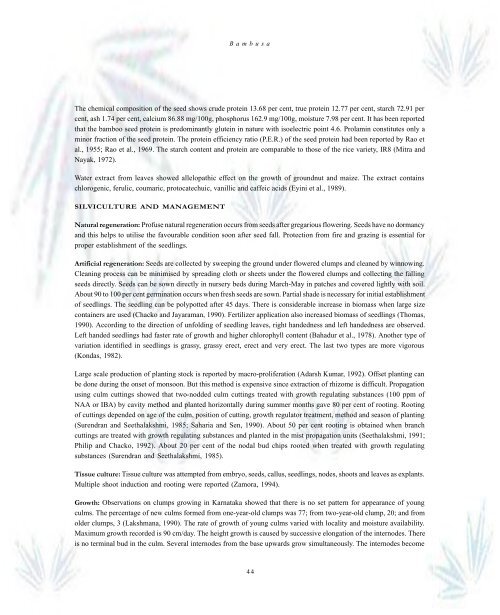Create successful ePaper yourself
Turn your PDF publications into a flip-book with our unique Google optimized e-Paper software.
Bambusa<br />
The chemical composition of the seed shows crude protein 13.68 per cent, true protein 12.77 per cent, starch 72.91 per<br />
cent, ash 1.74 per cent, calcium 86.88 mg/100g, phosphorus 162.9 mg/100g, moisture 7.98 per cent. It has been reported<br />
that the bamboo seed protein is predominantly glutein in nature with isoelectric point 4.6. Prolamin constitutes only a<br />
minor fraction of the seed protein. The protein efficiency ratio (P.E.R.) of the seed protein had been reported by Rao et<br />
al., 1955; Rao et al., 1969. The starch content and protein are comparable to those of the rice variety, IR8 (Mitra and<br />
Nayak, 1972).<br />
Water extract from leaves showed allelopathic effect on the growth of groundnut and maize. The extract contains<br />
chlorogenic, ferulic, coumaric, protocatechuic, vanillic and caffeic acids (Eyini et al., 1989).<br />
SILVICULTURE AND MANAGEMENT<br />
Natural regeneration: Profuse natural regeneration occurs from seeds after gregarious flowering. Seeds have no dormancy<br />
and this helps to utilise the favourable condition soon after seed fall. Protection from fire and grazing is essential for<br />
proper establishment of the seedlings.<br />
Artificial regeneration: Seeds are collected by sweeping the ground under flowered clumps and cleaned by winnowing.<br />
Cleaning process can be minimised by spreading cloth or sheets under the flowered clumps and collecting the falling<br />
seeds directly. Seeds can be sown directly in nursery beds during March-May in patches and covered lightly with soil.<br />
About 90 to 100 per cent germination occurs when fresh seeds are sown. Partial shade is necessary for initial establishment<br />
of seedlings. The seedling can be polypotted after 45 days. There is considerable increase in biomass when large size<br />
containers are used (Chacko and Jayaraman, 1990). Fertilizer application also increased biomass of seedlings (Thomas,<br />
1990). According to the direction of unfolding of seedling leaves, right handedness and left handedness are observed.<br />
Left handed seedlings had faster rate of growth and higher chlorophyll content (Bahadur et al., 1978). Another type of<br />
variation identified in seedlings is grassy, grassy erect, erect and very erect. The last two types are more vigorous<br />
(Kondas, 1982).<br />
Large scale production of planting stock is reported by macro-proliferation (Adarsh Kumar, 1992). Offset planting can<br />
be done during the onset of monsoon. But this method is expensive since extraction of rhizome is difficult. Propagation<br />
using culm cuttings showed that two-nodded culm cuttings treated with growth regulating substances (100 ppm of<br />
NAA or IBA) by cavity method and planted horizontally during summer months gave 80 per cent of rooting. Rooting<br />
of cuttings depended on age of the culm, position of cutting, growth regulator treatment, method and season of planting<br />
(Surendran and Seethalakshmi, 1985; Saharia and Sen, 1990). About 50 per cent rooting is obtained when branch<br />
cuttings are treated with growth regulating substances and planted in the mist propagation units (Seethalakshmi, 1991;<br />
Philip and Chacko, 1992). About 20 per cent of the nodal bud chips rooted when treated with growth regulating<br />
substances (Surendran and Seethalakshmi, 1985).<br />
Tissue culture: Tissue culture was attempted from embryo, seeds, callus, seedlings, nodes, shoots and leaves as explants.<br />
Multiple shoot induction and rooting were reported (Zamora, 1994).<br />
Growth: Observations on clumps growing in Karnataka showed that there is no set pattern for appearance of young<br />
culms. The percentage of new culms formed from one-year-old clumps was 77; from two-year-old clump, 20; and from<br />
older clumps, 3 (Lakshmana, 1990). The rate of growth of young culms varied with locality and moisture availability.<br />
Maximum growth recorded is 90 cm/day. The height growth is caused by successive elongation of the internodes. There<br />
is no terminal bud in the culm. Several internodes from the base upwards grow simultaneously. The internodes become<br />
44


